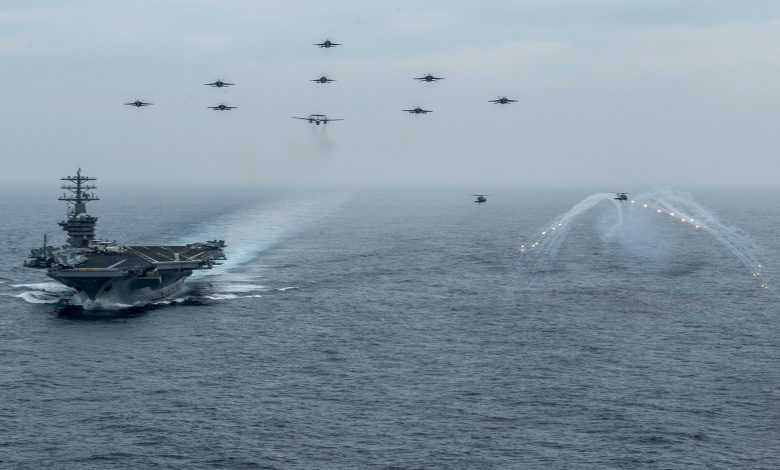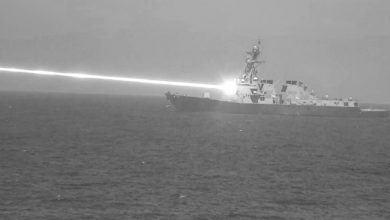Analysis: Could the third Taiwan Strait crisis lead to a war between China and America?

Twenty-one years ago this week, as Taiwanese were readying to hold their country’s first direct presidential election later in March, China flexed its military muscles by holding a series of military exercises and firing missiles within thirty-five miles off the ports of Keelung and Kaohsiung, causing a panic in Taiwan and prompted U.S. President William J. Clinton to deploy a carrier battle group to international waters near Taiwan.
The Third Taiwan Strait Crisis, as the events came to be known, disrupted naval shipping and commercial air traffic, causing harm to Taiwan’s economy. Amid fears of a possible invasion—fuelled by planned People’s Liberation Army (PLA) exercises simulating an amphibious assault and live-fire exercises near the outlying island of Penghu—Taiwanese scrambled to reserve seats on flights to North America.
In the end, crisis was averted, likely due to the U.S. intervention, and Beijing’s efforts to coerce the Taiwanese backfired: Lee Teng-hui, the candidate from the ruling Kuomintang (KMT) whom China suspected had pro-independence inclinations, was elected with a majority instead of the expected mere plurality. According to historians, China’s military threat gave Lee a 5% boost in the March 23 election, the first indication, perhaps, that coercion, rather than cow the Taiwanese into submission, was a counterproductive policy.
Besides exacerbating momentum toward a more Taiwan-centric sentiment across the fledging democracy, Beijing’s military maneuvers (which had begun a year prior in response to President Lee’s visit to the U.S.) likely also convinced Washington of the necessity of providing Taiwan with more means to defend itself as part of its policy under the Taiwan Relations Act of 1979, passed in response to the establishment of official diplomatic relations between the United States and the People’s Republic of China (PRC).
While many historians argue that the mass killings surrounding the 2-28 Incident of 1947 by KMT forces constituted the “birth certificate” of Taiwan as a distinct nation, it could also be argue that the Missile Crisis of 1995–96 represented a breaking point in the Taiwan Strait, when Beijing’s belligerence made it clear it would not countenance the wishes of the Taiwanese to continue down the road of democratization after nearly four decades of authoritarian rule. Years before it became fashionable to do so, China’s actions made it clear that the “one country, two systems” framework, formulated by paramount leader Deng Xiaoping in the early 1980s to handmaiden the reunification of Hong Kong, Macau and eventually unification with Taiwan—was seriously flawed.
Learning from its overreaction and humbled by the U.S. naval deployment, Beijing did not resort to similar intimidation as Taiwanese continued to exercise their democratic right. It even showed self-restraint when, for the first time in 2000, a candidate from the pro-independence Democratic Progressive Party (DPP) was elected in 2000 and re-elected in 2004. Beijing’s rhetoric remained harshly opposed to Taiwan independence, but it had learned that coercion by military means was counterproductive. Instead, Beijing shifted its strategy, and for the next decade and a half it instead attempted to win the hearts and minds of the Taiwanese through economic interdependence, a process that deepened under President Chen Shui-bian of the DPP and accelerated by leaps and bounds under his successor, Ma Ying-jeou of the KMT (2008–16).
Nevertheless, the injury to Chinese pride in 1996, as well as the display of overwhelming U.S. military capability during the Gulf War of 1991, convinced Beijing of the need to modernize its military. The result was an intensive program of double-digit investment, foreign acquisitions (primarily from Russia and the Ukraine) and indigenous resourcing to turn the PLA into a force capable of imposing Beijing’s will within its immediate neighborhood and, eventually, beyond. China’s embracing of an anti-access/area-denial (A2/AD) strategy, supported by the means to enforce such a plan, was a direct response to the humiliation it suffered in 1996 at the hands of what it regarded as a “foreign intervention.”
Thus, a direct line can be drawn between the Third Taiwan Strait Crisis and China’s current efforts to displace the U.S. as the hegemon in the Asia-Pacific. The repercussions of this national trauma reverberate through time and are inarguably part of Beijing’s rationale for creating a new naval architecture all the way to the South China Sea, which it is busy militarizing, and beyond into the West Pacific.
Besides China’s growing missile arsenal, which it should be stated does not only target Taiwan, North Korea’s nuclear and missile programs has also awakened the region to the threat. South Korea, Japan, Taiwan, Vietnam and the Philippines are now all potential targets to missile attack by an adversary. Earlier this week, Pyongyang test-fired four ballistic missiles, ostensibly as part of a simulated attack on U.S. military bases in Japan. Meanwhile, in response to the threat from the North, South Korea has agreed to the deployment of a U.S.-made Terminal High Altitude Area Defense (THAAD) system on its territory, with the first units arriving earlier this week. Beijing, which sees a potential use of the system to counter its own missile force (including the possibility that the radar systems could be used to monitor the Chinese military), has reacted with consternation and launched a series of punitive measures against South Korea.
For its part, Japan is a target of both North Korean missiles and, due to its longstanding disputes with China over history and territory in the East China Sea, to PLA attacks. U.S. military bases across Japan, which would play a crucial role in contingencies in both the Korean Peninsula and the Taiwan Strait, would be prime targets during the initial phase of hostilities, particularly if China decided to launch major military operations against Taiwan. Given the threat it faces on two fronts, Japan, working in conjunction with the U.S. military, has had every incentive to take early warning, tracking, air defense and mitigation seriously. Pyongyang’s missile tests, while unsettling, have nevertheless contributing to better preparedness by the Japan Self-Defense Force (JSDF) and U.S. military forces deployed in the region.
Should tensions between China and North Korea on one side and South Korea, Japan, Taiwan and the U.S. on the other continue to increase—much of this contingent on the kind of policies the Donald J. Trump administration adopts for the region—the latter group may feel compelled to increase intelligence sharing on the missile threat emanating from China and North Korea. U.S. satellite and aerial surveillance, combined with South Korea’s early warning systems (including the X-band AN/TPY-2 radar guiding the THAAD system), Japan’s EW systems and Taiwan’s long-range early-warning radar on Leshan—a modernized version of the AN/FPS-115 Pave Paws which can track any air-breathing target 4,000 km inside China—could form the basis of a nascent missile tracking/intercept quadrumvirate within the region.
As one of the corners of that square and due to its proximity to China, Taiwan should do its utmost to ensure it has a seat at the table, both as a provider and consumer of such critical real-time EW information. Given the affinity between Japan and Taiwan for historical reasons, Japanese jitters at the thought of a PLA presence in Taiwan, and the greater role the U.S. is expected to give Tokyo in a transforming regional security architecture, the time might be ripe for closer security cooperation between Tokyo and Taipei, something which may already have begun since the election of the DPP’s Tsai Ing-wen to the presidency in 2016.
Buttressing the desire to share intelligence (and perhaps technology), moreover, is the fact that all four countries are U.S. allies/partners and democracies aligned against two revisionist, authoritarian, and destabilizing regimes. Thus, despite the growing threat it faces from an increasingly powerful China and the high uncertainty surrounding the future of the region, circumstances—particularly the potential for Beijing to alienate Seoul should the relationship continue to sour—could in fact turn more favorable for Taiwan, thus creating an opportunity to play a greater role in regional security.





